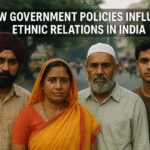In rural India, the issue of girls’ education remains one of the most pressing challenges in the pursuit of gender equality. While significant strides have been made to promote access to education for girls, many rural areas continue to face obstacles that hinder the development of adequate educational facilities. Factors like poverty, cultural norms, lack of infrastructure, and safety concerns create a complex web of challenges that prevent girls from receiving the education they deserve.
Access to Education: A Growing Challenge
India has made substantial progress in improving the enrollment rates of girls in schools over the past few decades. Initiatives such as the Right to Education (RTE) Act and schemes like Beti Bachao Beti Padhao have contributed to increasing the number of girls attending school. However, the situation in rural India remains far from ideal. Despite government efforts, many girls still face significant barriers to education:
- Infrastructure and Facilities
The availability and quality of educational facilities in rural areas are often inadequate. According to a 2021 National Family Health Survey (NFHS) report, over 30% of rural schools lack separate toilets for girls, a basic necessity for ensuring that they can attend school regularly, especially during menstruation. Similarly, many schools in rural areas are understaffed, with teachers often not trained to handle the specific needs of young girls.
In addition, a lack of basic infrastructure such as drinking water, sanitation facilities, and electricity in rural schools makes it difficult for girls to stay in school, particularly as they grow older.
- Distance and Transportation
The physical distance between schools and the homes of rural girls is another significant barrier. Many rural schools, particularly in remote areas, are located far from students’ homes, making it difficult for girls to attend. In many cases, girls are forced to drop out when they reach puberty because it becomes difficult or unsafe for them to travel long distances to school.
Even in areas where transportation is available, it is often unreliable or unsafe, especially for young girls. The lack of safe and affordable transportation further discourages parents from sending their daughters to school, particularly in communities where the value of girls’ education is not fully recognized.
Cultural and Socioeconomic Barriers
In rural India, deep-rooted cultural norms and socio-economic factors play a critical role in limiting access to education for girls. Many families prioritize boys’ education over girls’, viewing girls as future homemakers. In such communities, girls are often expected to contribute to household chores or take care of younger siblings, leaving them with little time or energy to attend school.
- Gender Norms and Social Expectations
Societal attitudes regarding the role of women are a major barrier to girls’ education in rural India. In some rural areas, there is a prevailing belief that educating girls is unnecessary since they are expected to marry and manage households. These deeply ingrained gender norms discourage parents from investing in their daughters’ education, especially when financial resources are limited. - Child Marriage
Child marriage remains prevalent in rural India, where girls as young as 14 are married off, often as a result of poverty and societal expectations. This practice severely disrupts girls’ education, as they are forced to leave school once married. Despite legal prohibitions, child marriage is still widespread, particularly in rural and tribal communities, further limiting girls’ opportunities for education. - Economic Constraints
Poverty remains a significant challenge in rural India, and many families struggle to afford basic necessities. Education, especially for girls, is often seen as an unnecessary expense. Parents may choose to send boys to school instead of girls, or pull girls out of school when financial pressures mount, especially if they have to pay for uniforms, books, or transportation.
Government Efforts and Their Limitations
The Indian government has implemented several policies and schemes aimed at improving girls’ education, but their impact has been uneven, especially in rural areas:
- Scholarships and Financial Incentives
Programs like Kasturba Gandhi Balika Vidyalaya (KGBV) and scholarships for girls from economically disadvantaged families have been introduced to encourage girls to stay in school. While these initiatives have helped in some areas, they remain underfunded and limited in scope. Moreover, the distribution of scholarships and benefits is often inconsistent, especially in far-flung rural areas. - Community-Based Programs
Government initiatives like Beti Bachao Beti Padhao and community awareness campaigns aim to change societal attitudes towards girls’ education. While these programs have raised awareness, there is often a disconnect between policy implementation and local cultural norms, especially in remote rural areas where education for girls is still not viewed as a priority. - Mid-Day Meal Scheme
The government’s Mid-Day Meal Scheme aims to improve school enrollment and attendance by providing free meals to students. While this has encouraged more girls to attend school, the scheme’s implementation in rural areas is often marred by logistical issues and inconsistencies in food quality.
The Path Forward: Improving Girls’ Education in Rural India
Addressing the challenges of girls’ education in rural India requires a multi-pronged approach:
- Improved Infrastructure
A significant investment in school infrastructure is needed to create a safe and supportive learning environment for girls. This includes building separate toilets for girls, providing safe transportation, ensuring adequate teaching resources, and improving access to digital tools for education. - Community Engagement
Engaging communities and changing entrenched attitudes toward girls’ education is crucial. Community-based programs that involve local leaders, parents, and teachers can help shift perceptions and emphasize the importance of girls’ education. Awareness campaigns and sensitization programs can play a key role in changing social norms. - Policy Implementation and Monitoring
Strengthening the implementation of policies like the Right to Education Act and ensuring that benefits reach the most marginalized girls in rural areas is essential. Monitoring and accountability mechanisms are needed to ensure that schools are meeting the needs of girls and that schemes designed to support their education are effective and accessible. - Financial and Social Support
Financial incentives, such as scholarships, free textbooks, and uniforms, should be expanded and better targeted to rural girls. Additionally, addressing child marriage and poverty through legal reforms and social welfare programs is essential for ensuring that girls can complete their education without interruption.
Conclusion
Girls’ education in rural India is still far from adequate, with numerous challenges such as infrastructure deficits, socio-economic pressures, and cultural barriers. While the government and various NGOs have made efforts to improve access to education for girls, these efforts have been inconsistent and insufficient in many rural areas.
To ensure that all girls in rural India receive an education, the country must commit to addressing these systemic barriers with targeted policies, increased investment in infrastructure, and a long-term commitment to changing societal attitudes towards girls’ education. Only then can India unlock the full potential of its girls and secure a more equitable future for all.












